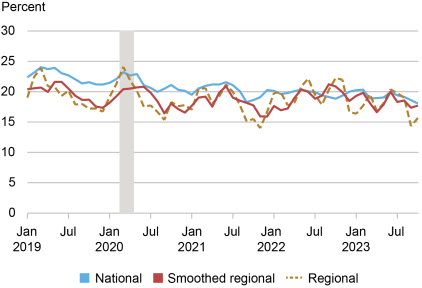Recent Disparities in Earnings and Employment


The New York Fed recently released its latest set of Equitable Growth Indicators (EGIs). Updated quarterly, the EGIs continue to report demographic and geographic differences in inflation, earnings (real and nominal), employment, and consumer spending (real and nominal) at the national level. This release also launches a set of national wealth EGIs (which will be examined more closely on Liberty Street Economics early next year). Going forward, EGI releases will also include a set of regional EGIs, which will present disparities in inflation, earnings (real and nominal), employment, and consumer spending (real and nominal) in our region. Drawing on the just released EGIs, in this post, we present recent gender gaps in the labor market at the national and regional levels. We provide a picture of how gender wage and employment disparities have evolved since the pandemic, examining and contrasting gaps at the national and regional level. We find that the gaps between the employment rates and earnings of men and women have declined steadily following the pandemic, but have declined perceptibly more so in our region than in the nation.
Data
We use monthly, seasonally adjusted data on average weekly earnings and employment for men and women aged sixteen and older from the Current Population Survey. Creating a national panel, we draw a data set from respondents in all fifty states and Washington, D.C. We also conduct an analysis at the regional level, which includes respondents residing in New York State and the New York Metropolitan Statistical Area, except for Pennsylvania. We consider the time period from January 2019 to October 2023.
Labor Market Disparities
Gender wage and employment gaps have long been a persistent feature of the U.S. economy. At the onset of the COVID-19 pandemic, there was much uncertainty over how the event would impact these disparities. The shuttering of daycare centers and schools introduced concerns about the disproportionate number of women leaving the workforce to care for their children.
A more permanent change to labor market paradigms has been the rise in popularity of remote work. As more and more companies offered remote work options, many people have wondered: whether the increased flexibility would improve women’s labor market participation; whether women disproportionately taking advantage of remote work would be penalized compared to men who work in-person; or if the decline in childcare provided by in-person schooling might hinder women’s labor force participation. We examine how the labor market trends have evolved in the nation and in the region.
Employment Disparities
The gender gap for the employment to population ratio (or employment rate) at the national and regional levels between January 2019 and October 2023 is shown in the chart below. The employment gap is defined as the percentage point difference between the employment rate for men and the employment rate for women. Before the March 2020 pandemic and recession, the national and regional gender employment gaps were roughly equal, 12 and 12.6 percentage points, respectively. However, during the pandemic recession, both the national and the regional gender gap increased sharply, with the national gap approaching 13 percentage points in June 2020 and the regional gap exceeding 14 percentage points in August 2020. Women were more likely to exit employment than men during the pandemic recession for a variety of reasons, including more tenuous attachment to the labor force, shorter tenure in their current job, and the absence of in-person schooling as a source of childcare.
The Gender Employment Gap Has Declined at the National Level since the Pandemic but Perceptibly More Sharply in the Region

After these temporary increases, the national and regional gender employment gaps decreased at steady rates until mid-2022. Since then, the regional disparity declined perceptibly faster than the national gap. By October 2023, the gender employment gap had shrunk to around 10.9 percentage points at the national level and 8.7 percentage points at the regional level. Thus, employment gaps for women that initially widened at the onset of the pandemic have returned to a declining trend and fallen to well below pre-pandemic levels. The gender gap also declined faster in the region than in the nation as a whole. Although the regional and the national gap were very close in 2019, the regional gender gap is now over 2 percentage points less than the national gap.
Earnings Disparities
We now turn to looking at the gender gap in earnings, defined as the percentage difference between the earnings of men and women. The regional and national gender earnings gap trends, displayed in the chart below, are more volatile than the employment gaps. As the regional gaps are particularly volatile, we also present a smoothed regional gap to better appreciate the ways in which the regional gaps differ from the national gaps.
In 2019 and early 2020, both national and regional gender earnings gaps were decreasing, with disparities in our region substantially smaller than national ones. In December 2019, before the onset of the pandemic, gender earnings gaps hit a trough of 21.2 percent at the national level and 16.7 percent at the regional level, implying women earned 78.8 percent and 83.3 percent of what men earned, respectively. However, the declining trend was reversed as the pandemic brought on labor market changes, with women earning as much as 24 percent less than men at both the regional and national level in March 2020.
Part of the reason for this sharp reversal may have been selection: many lower-earning jobs mostly held by men, may have borne the brunt of layoffs during the very acute contraction of March 2020, leading to the men remaining employed being disproportionately those with higher earnings. Another reason may have been that women, who could afford to, dropped out of the labor force for childcare, as schools closed at the beginning of the pandemic.
Gender Earnings Gap Has Declined at the National Level since the Pandemic, but More So in the Region

As the pandemic eased, gender earnings gaps in both the nation and region declined. However, the regional gap flatlined between early 2022 and mid-2023, declining after that. In contrast, the national gap continued to decline slowly but steadily following the pandemic. The smoothed version of the regional gap shows more clearly that gender earnings disparities declined more sharply in the region than in the nation immediately following the pandemic, and generally remained lower than those in the nation. The national gap is less volatile, gradually decreasing to 18 percent by the end of October 2023. The regional gap did not decrease as rapidly for much of 2023, but has fallen to 16 percent in recent months.
Looking at the real earnings of men and women separately, as we do in this quarter’s EGIs, both in the nation as a whole and even more starkly in the region, women’s real earnings have tended to grow consistently faster than the real earnings of men. Overall, between January 2020 and October 2023, the national and regional gender earnings gap have decreased by more than 3 percentage points each. As of October 2023, men make 16 percent more than women do in our region, compared to 18 percent in the nation.
Conclusion
With the rise of remote work in recent years and the shock of the COVID-19 pandemic, it has been an open question how gender gaps in the labor market would evolve. We provide an analysis of trends in gender employment and earnings gaps at the national and regional level drawing on the New York Fed EGIs. We find that after initial increases during the COVID-19 pandemic, gender gaps at the national and regional level have decreased to below pre-pandemic levels for both employment rate and earnings. Although national and regional employment gaps were similar pre-pandemic, by October 2023 both employment and earnings gaps have become substantially lower in our region—which was particularly affected by the pandemic and its associated changes—compared to the national level.
Our findings are consistent with the increased incidence of work from home following the COVID-19 pandemic, which offered workers greater flexibility in balancing career and family. Women, especially more educated women, disproportionately took advantage of working from home, relative to before, which led to their increased: labor force participation, employment rate, and earnings relative to those of men. This effect may have been stronger in our region because of its relatively greater reliance on remote work, and because of its relatively more educated female workforce that was better positioned to take advantage of remote work. By making it easier to combine career and family, in the words of 2023 Nobel Laureate Claudia Goldin, remote work may have provided a “silver lining” to the effect of the pandemic on women.
National Earnings Report National Employment Report
Regional Earnings Report Regional Employment Report

Rajashri Chakrabarti is the head of Equitable Growth Studies in the Federal Reserve Bank of New York’s Research and Statistics Group.

Kasey Chatterji-Len is a research analyst in the Federal Reserve Bank of New York’s Research and Statistics Group.

Dan Garcia is a research analyst in the Federal Reserve Bank of New York’s Research and Statistics Group.

Maxim Pinkovskiy is an economic research advisor in Equitable Growth Studies in the Federal Reserve Bank of New York’s Research and Statistics Group.
How to cite this post:
Rajashri Chakrabarti, Kasey Chatterji-Len, Dan Garcia, and Maxim Pinkovskiy, “Recent Disparities in Earnings and Employment,” Federal Reserve Bank of New York Liberty Street Economics, December 1, 2023, https://libertystreeteconomics.newyorkfed.org/2023/12/recent-disparities-in-earnings-and-employment/.
Disclaimer
The views expressed in this post are those of the author(s) and do not necessarily reflect the position of the Federal Reserve Bank of New York or the Federal Reserve System. Any errors or omissions are the responsibility of the author(s).





